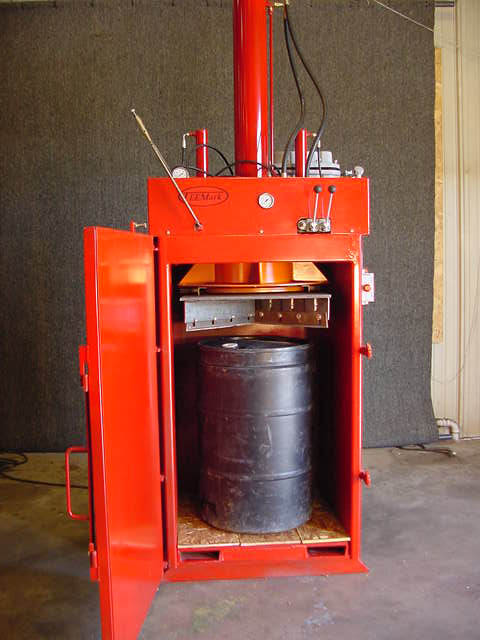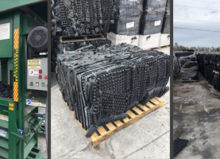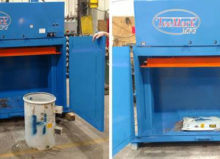What is a Drum Crusher?
 Drum Crushers are designed specifically to crush empty steel and fiber drums into 5” high drum pancakes. Some Drum Crusher models allow their users to compact material inside drums (In-Drum Packing) and crush the drums when full. Soiled rags, spray booth filters, air filters, oil filters, oil cans, oil containment booms and paint cans, can be packed inside 55-gallon steel or fiber drums for disposal, incineration, or transport. Some Drum Crushers are designed to be used as an attachment on a skid steer.
Drum Crushers are designed specifically to crush empty steel and fiber drums into 5” high drum pancakes. Some Drum Crusher models allow their users to compact material inside drums (In-Drum Packing) and crush the drums when full. Soiled rags, spray booth filters, air filters, oil filters, oil cans, oil containment booms and paint cans, can be packed inside 55-gallon steel or fiber drums for disposal, incineration, or transport. Some Drum Crushers are designed to be used as an attachment on a skid steer.
Frequently asked Questions
Who would benefit from a Drum Crusher?
Military installation, Pharmaceutical Processor, Manufacturing Plants, Steel Recycler, Recycling Centers, Chemical and Materials Companies, Processing and Packaging Facilities, Environmental Organization, Labs and Hazardous Waste Generators, City and Town Municipalities and Food Processing & Packaging Plants.
What drums/barrels can you crush?
- Steel, Plastic, Fiber Drums
- 30-gallon drums
- 55-gallon drums
- 85-gallon drums
- Even larger drums
How much footprint does a Drum Crusher need?
- V43DC – 59″ wide X 37″ deep x 113″ high
- DC55 Series – 32″ wide X 32″ deep x 94″ high
- DPC60 Series – 32″ wide X 32″ deep x 114″ high
- DPC85 Series – 53″ wide X 46″ deep x 120″ high
- DPC150 Series – 53″ wide X 48″ deep x 120″ high
How much does a Drum Crusher weigh?
- V43DC – 3500 lbs.
- DC55 Series – 1400 lbs.
- DPC60 Series – 2350 lbs.
- DPC85 Series – 4000 lbs.
- DPC150 Series – 4000 lbs.
How does a Drum Crusher ship?
Standing up and secured on a flatbed truck
How do you unload a Drum Crusher from the truck?
A fork-lift is the most used machine for unloading the vertical baler from the shipping
truck. The lifting equipment must be designed for lifting the weight of the Drum Crusher.
Installation Considerations for a Drum Crusher
DRUM CRUSHER INSTALLATION
1. Tools required to install a TeeMark Drum Crusher.
2. Forklift, 9/16” wrench, ¾” wrench, 1” wrench, hammer, pry bar, chain and hook to raise the cylinder.
3. Using the hammer and pry bar, remove the panels from the crate. Locate the four lag bolts that attach the crusher to the crate. Using the 9/16” wrench remove the lag bolts.
4. The Drum Crusher has fork pockets built into the frame for transporting. Move the Drum Crusher to the desired location with the forklift. Anchoring to the floor is at the customer discretion. If you desire to anchor to the crusher, use the four holes provided in the fork pockets for this purpose.
5. After locating the Drum Crusher to the desired position, open the door and locate the four ½” hex head bolt supplied. These bolts are provided to attach the cylinder to the frame. The cylinder is shipped in the lowered position; locate the eye hood on the top of the cylinder. Using the chain and hook, attach the top of the cylinder to one of the forks on the forklift. You will need to use the 1” wrench to loosen the hydraulic lines; this will enable them to rotate. Slowly raise the cylinder until it comes in contact with the frame inside the Drum Crusher. You will have to orientate the mounting base with the crusher frame to align the holes, and hydraulic lines. Attach the cylinder to the frame; be sure the four bolts re tight. Remove the forklift and chains. Realign the hydraulic hoses and tighten them.
6. Have the electrician wire to the Drum Crusher in accordance with local codes.
7. After the crusher has been set into place and wired, check the oil level in the sight glass located on the tank attached to the rear of the machine. Oil should be visible to within ¾ of the top of the glass.
8. Start the hydraulic motor by pulling out the e-stop button on the motor starter enclosure. Check for signs of leaks in the hydraulic lines. If you find leads you may need to tighten the fittings. Once you are sure there are no leaks, you are ready to operate the machine. Refer to the operating instructions in this manual.
9. You may experience some noise for the first couple of cycles, as there may be air in the system. Cycling the Drum Crusher several times will work the air out of the system.
Initial Start Up
WIRING
Connect wiring to Drum Crusher in accordance with local and national electrical codes (see attached wiring diagram)
HYDRAULIC FLUID
Check the hydraulic fluid level. Oil should be at a level that is visible in the temperature sight gauge throughout the complete ram cycle. When adding oil, use a premium grade anitwear hydraulic oil, 150 viscosity grade 32, (Mobile #DTE24 or equal). This is the same antiwear hydraulic fluid that is typically used in farm tractors and dump trucks. It should be available in auto supply store. The unit holds approximately 8 gallons of hydraulic oil.
PUMP ROTATION
The motor fan should turn in a clockwise rotation as viewed from the rear for proper pump rotation. Jog electric motor to observe rotation and correct if necessary. Single phase units have proper rotation preset at the factory.
INITIAL CYCLE
Start the unit. The pump should prime within one minute. Do not run the pump longer if it does not prime.
Cycle the unit several times to bleed air from the hydraulic lines. It may be necessary to break the fittings at the top of the cylinder to bleed air form the lines if the motion is not smooth after 10-20 cycles.
Recheck the fluid reservoir and fill to top of gauge with the ram retracted.
VALVE SETTINGS
The pressure relief valve and squeeze (detent) pressure have been preset at the factory for optimum performance. DO NOT INCREASE THESE SETTINGS as this will exceed the capacity of the equipment and cause damage. Lowering the squeeze valve detent pressure below the factory seeing of 3000 psi is permissible (see detent adjustment instructions)
FILTER CARTIDGE
Change the filter cartridge after the first 100 hours of operation.
How does a Drum Crusher work?
DRUM CRUSHING
1. Place the Drum in the center of the Drum Crusher. It is not necessary to remove the bungs from the Drums because the piercer will puncture the Drum top and vent the air inside the Drum as it is crushed. Open top drums crush straighter when placed in the crusher with the open end down.
2. Close and latch the door. A door interlock prevents the crusher from operating with the door open.
3. Start the hydraulic pump
a. Electric models: pull the emergency stop button.
b. Gasoline or diesel engine models: start engine
4. To start the crushing cycle pull both valve handles toward you until they lock onto position. These handles are located above the door on the door latch side.
5. The ram will crush the drum and automatically return to the up position at the end of the cycle. As the drum is crushed, hydraulic pressure increases. When the maximum pressure is reached, the left valve handle will snap back. At this point the ram begins to retract. When the ram is fully retracted in the up position, the right valve handle will snap back. The cycle can be manually over-ridden at any time by operating the appropriate valve handle.
If the valve handles are not returning automatically or if they return too soon, see the detent adjustment instructions.
6. When both handles have returned, open the door, and remove crushed drum. It is not necessary to turn off the engine or electric powered hydraulic pumps between cycles.
IN-DRUM COMPACTION – OPTIONAL FEATURE
1. To remove the crushing head, remove the four bolts that hold the crushing head into the ram and slide the crushing head form the smaller compaction head.
2. Carefully place the drum in the center of the crusher over the drum centering disc on the drum centering pallet. The centering disc not only holds the drum in place, it protects the bottom bead of the drum from damage during compaction. Some models have more than one centering disc. Be sure you are using the proper one.
3. Add the material to be compacted
4. Close and latch the door. A door interlock prevents the crusher form operating with the door open.
5. Start the hydraulic pump.
a. Electric models: Pull out the emergency stop button.
b. Gasoline and Diesel engine models: Start the engine
6. To start the compaction cycle pull both valve handles toward you until they lock onto position. These handles are located above the door on the door latch side.
7. A force gauge is provided which indicates the compaction force being applied to the drum contents. It is not desirable to use the full ram force during compaction as you might deform the drum the suggested ran force for compaction is: Model DPC60/500lbs, DPC85/350lbs, and DPC150/200lbs.
The operator can reduce the compaction force in two ways:
a. Manually override the valve when the desired force is reached by returning the left valve handle to tis neutral position (push the handle toward the valve). This will shift the valve to automatically retract the ram.
b. Reduce the pressure setting on the automatic cycle valve. To do this change the detent adjustment located at the top rear of the valve behind the left handle (see detent adjustment instructions). Reduce the pressure by turning the adjusting bolt counter-clockwise. Cycle the valve until it returns at the desired pressure. Then tighten the lock nut.
8. The ram automatically return to the up position at the end of the cycle. As the material is compacted within the drum, the hydraulic pressure increases. When the preset pressure is reached, the left valve handle will snap back. At this point the ram begins to retract. When the ram is fully retracted in the up position, the right valve handle will snap back. The cycle can be manually overridden at any time by operating the appropriate valve handle.
If the valve handles are not returning automatically or if they return too soon, see the detent adjustment instructions.
9. More material can be added and compacted over and over until the drum is full.
It is not necessary to turn off the engine or electric powered hydraulic pumps between cycles.
10. Remove the packed drum by lifting the drum centering pallet out with a forklift. Once outside the crusher, the drum can be handled by conventional drum handling equipment.
Drum Crusher Electrical Options
Depending on the model
- 230 or 460 Volt 3-Phase
- 220 Volt Single Phase
- 8 Gasoline Engine
- 9 Diesel Engine w/ electric start
Drum Crusher Hydraulic Oil
When adding oil, use a premium grade anitwear hydraulic oil, 150 viscosity grade 32, (Mobile #DTE24 or equal).
Drum Crusher Safety System can Include
An emergency stop button shuts off all power at a touch. A safety interlock automatically shuts off the hydraulic power when the door is not completely closed.
Drum Crusher Preventative Maintenance
RECOMMENED PERIODIC MAINTENACNE
1. Change the filter element after the first 100 hours of operation and then every 500 hours after that; more often if your system is in an extremely dirty atmosphere.
2. Grease motor bearing to manufacturer’s recommendations.
3. Change the hydraulic oil completely every 5000 hours of operation or after 5 years.
4. Remember your system is only as good as your maintenance.
Drum Crusher Options
- Drum Cutter for DPC60 and larger packer/crushers, to cut plastic drums
- Door Chute 10” opening
- 5” Flange
- Hydraulic Drum Hold Down for Series DPC60
- Liquid Containment Pans
- Filter Crusher Insert for all packer/crusher. Extra long filter crusher insert handles filters up to 42” long.
- Drum Piercer
- HEPA Filter
- Special Voltage
- 50Hz Motors
BACE, LLC Drum Crusher
At 56000 pounds of crushing force, the BACE, LLC V43DC can crush a steel drum down to a height of 4-6 inches tall. Simple pushbutton operation and automatic cycling makes this machine ideal for a military installation, a pharmaceutical processor or a manufacturing plant and recyclers.
This unit can convert into an inside-the-drum waste compactor by getting an extra compaction head sized for a 55-gallon drum. You have the option of doing this now or years down the road.
TeeMark, MFG. Drum Crushers and In-Drum Packers
The TeeMark, Mfg. Drum Crusher Series DC55 has been carefully engineered for rugged industrial service and durability at a reasonable price. It crushes 55-gallon steel drums to 4-6 inches in 35 seconds. It also excels at crushing smaller drums and cans. We offer four electric motor choices and a gasoline and diesel power engine. Custom modifications and a full line of accessories are available to meet any special requirements
The TeeMark, Mfg. Drum Crusher Series DPC 60 compacts material inside drums and crushes the drums. Hazardous or other waste can be packed inside 55-gallon steel or fiber drums for disposal or incineration. Steel drums are crushed to 3-5 inches in seconds. Custom modifications and a full line of accessories are available to meet any special requirements. This machine has 60,000 pounds of crushing force.
The TeeMark, Mfg. Drum Crusher Series DPC 85 compacts material inside drums and crushes the drum. This machine will crush drums up to 110-gallon capacity. Hazardous or other waste can be compacted inside of 85 & 55-gallon steel or fiber drums for disposal or incineration. Steel drums are crushed to 2-5 inches in just seconds. This machine has 85,000 pounds of crushing force.
The TeeMark, Mfg. Drum Crusher Series DPC 150 compacts materials inside of the drums and crushes the drum. This machine will crush drums up to 110-gallon capacity. Hazardous or other waste can be compacted inside 85 & 55-gallon steel or fiber drums for disposal or incineration. Steel drums are crushed to 2-5 inches in seconds. This machine has 150,00 pounds of crushing force.



